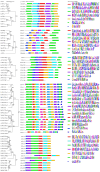Protein Prenylation in Plants: Mechanisms and Functional Implications
- PMID: 40573747
- PMCID: PMC12197051
- DOI: 10.3390/plants14121759
Protein Prenylation in Plants: Mechanisms and Functional Implications
Abstract
Protein prenylation is a crucial post-translational modification that involves the formation of a covalent bond between isoprenoid lipids and the cysteine residues of specific proteins. This modification plays a significant role in determining protein localization, facilitating protein-protein interactions, and ultimately influencing protein function within the cellular context. Prenylation is a conserved process observed across various kingdoms of life, including plants, animals, fungi, and protists. This review aims to consolidate existing knowledge regarding the mechanisms underlying protein prenylation, encompassing the biosynthetic pathways of isoprenoids in plants and the processing involved in the prenylation modification. Furthermore, it highlights the implications of alterations in protein prenylation on plant development, signaling pathways, and stress responses. The review also addresses the similarities in modification mechanisms between plants and animals, as well as the diversity of their functional implications. Finally, it outlines prospective research directions of the plant prenylation mechanisms and the potential applications in the field of biotechnology.
Keywords: farnesyltransferase; functional implications; geranylgeranyltransferase; modification mechanism; protein prenylation.
Conflict of interest statement
The authors declare no conflicts of interest.
Figures




Similar articles
-
Health professionals' experience of teamwork education in acute hospital settings: a systematic review of qualitative literature.JBI Database System Rev Implement Rep. 2016 Apr;14(4):96-137. doi: 10.11124/JBISRIR-2016-1843. JBI Database System Rev Implement Rep. 2016. PMID: 27532314
-
Home treatment for mental health problems: a systematic review.Health Technol Assess. 2001;5(15):1-139. doi: 10.3310/hta5150. Health Technol Assess. 2001. PMID: 11532236
-
Factors that influence parents' and informal caregivers' views and practices regarding routine childhood vaccination: a qualitative evidence synthesis.Cochrane Database Syst Rev. 2021 Oct 27;10(10):CD013265. doi: 10.1002/14651858.CD013265.pub2. Cochrane Database Syst Rev. 2021. PMID: 34706066 Free PMC article.
-
Cuproptosis: a novel therapeutic mechanism in lung cancer.Cancer Cell Int. 2025 Jun 24;25(1):231. doi: 10.1186/s12935-025-03864-1. Cancer Cell Int. 2025. PMID: 40555995 Free PMC article. Review.
-
A systematic review on endophytic fungi and its role in the commercial applications.Planta. 2023 Mar 1;257(4):70. doi: 10.1007/s00425-023-04087-2. Planta. 2023. PMID: 36856911
References
-
- Krute C.N., Carroll R.K., Rivera F.E., Weiss A., Young R.M., Shilling A., Botlani M., Varma S., Baker B.J., Shaw L.N. The disruption of prenylation leads to pleiotropic rearrangements in cellular behavior in Taphylococcus aureus. Mol. Microbiol. 2015;95:819–832. doi: 10.1111/mmi.12900. - DOI - PMC - PubMed
Publication types
Grants and funding
LinkOut - more resources
Full Text Sources

